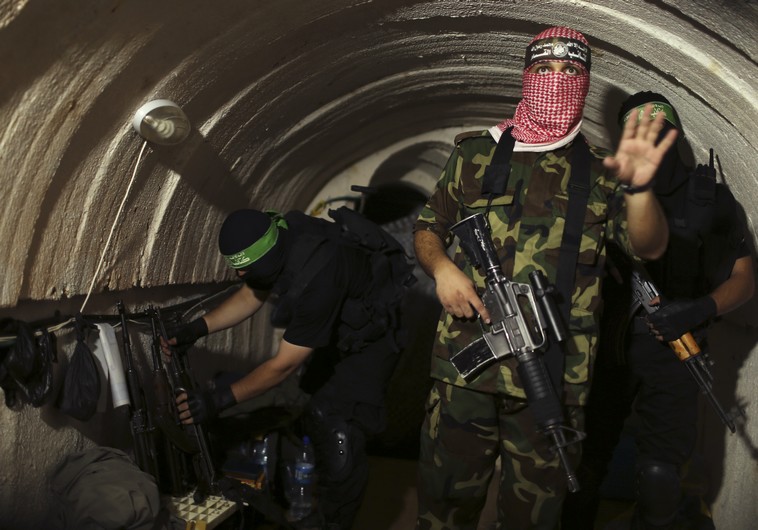Analysis: Hamas attack tunnels remain the greatest threat to Israel.
Photo:Hamas terror operatives in Gaza tunnel. (photo credit:REUTERS)
The IDF destroyed the last of the tunnels uncovered in the Gaza war on Monday, however Hamas continues to rebuild and improve what it knows is a vital strategic asset.
The IDF’s controlled explosion of a tunnel on Monday is a symbolic act that completes the achievement of one of the most important goals of last summer’s Gaza war – the destruction of some 30 Hamas attack tunnels.
The tunnel, located near the Gaza border in the area of the Karni crossing, some three kilometers from Kibbutz Nahal Oz, was uncovered during the war, but the destruction of the tunnel was controlled and carried out in coordination with local residents. It was a branch of an attack tunnel that started in Gaza’s Shejaiya neighborhood. The tunnel, found to contain old weaponry, was destroyed in order to prevent Hamas from using it again in a future war.
Hamas did indeed suffer damaging blows in the war. The uncovering and destruction of the tunnels was one of the heaviest blows dealt to the organization. The defense establishment speaks of a “deterred Hamas,” but the concept of deterrence is clearly fragile. Therefore, in the IDF it is estimated that it is just a matter of time until the next round of fighting. It could be a matter of months or years.
There is one undisputed point agreed upon in the defense establishment: Hamas is continuing in its efforts to learn lessons from the war and rehabilitate its military capabilities. A week does not go by without reports of the organization carrying out rocket-launching experiments from different sites in the Strip, westward into the sea.
Hamas is still finding it difficult to smuggle weapons into Gaza, especially rockets, because of good Israeli intelligence and because of Egypt’s contribution to weakening the organization. Egypt is demolishing houses between Sinai and the Strip to create a 1,000 meter buffer zone which could potentially be expanded to three kilometers from the border. Cairo sees Hamas as a group which must be combated due to its support of jihadist terror in Sinai.
However, this doesn’t prevent Hamas from making domestically-produced rockets. In the past six months, since the conclusion of the Gaza war, Hamas is believed to have made several hundred rockets, good for various ranges, of the types used during Operation Protective Edge. However it is not known at this point if Hamas has received technological help from Iran that could potentially improve the rockets’ range and accuracy.
Hamas is also trying to divert building materials and cement to reconstructing the tunnels, even though soil conditions in the area allow for relatively easy and quick digging that makes it possible to build sturdy tunnels with a limited amount of cement. Wooden support posts generally suffice.
Therefore, Israel’s biggest problem remains the tunnels. Hamas has begun digging them again with the understanding that they are a strategic tool which must be updated and improved, as well as doing everything possible to make it more difficult for Israel to detect and uncover them in the future.
Yossi Melman is an Israeli journalist and writer who specializes in security and intelligence affairs. He is co-author of Spies Against Armageddon: inside Israel’s Secret Wars.










